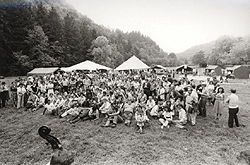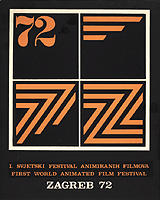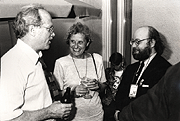Of the mighty ASIFA sanctioned festivals, Zagreb is perhaps the hidden gem that has survived through some terribly tough times and blows. Borivoj "Bordo" Dovnikovic supplies us with a history and look at Zagreb today.

Festival participants of Zagreb 1980.
The purpose of international festivals of animated film is to evaluate recent production in the field throughout the world, to look back on the history of animation by showing relevant national, personal or thematic retrospectives, and to organize meetings, discussions, lectures, exhibitions and similar events, all with as wide an audience as possible in mind. The aim is to promote and improve the art of film animation and animated film in general. This involves encouraging creativity which eschews pre-set patterns and ideas/notions/conceptions, and finds new ways of exploring the possibilities of film animation.
Zagrebs Place
Competitive festivals of animated films first appeared in 1960 following the foundation of ASIFA, the International Association of Animated Film. The first occasion was the biennial festival in the French town of Annecy, beneath the Alps. This soon became the cult meeting place of world animators. In the mid-Sixties, the international festival on the Black Sea in Mamaia, Romania, was founded, followed, in the Seventies, by a festival in Varna, Bulgaria. Neither lasted very long. Today there are many international festivals of animated films, and the biggest ones, beside Annecy and Zagreb, are Hiroshima, Ottawa, Stuttgart, Espinho and KROK, the Russian-Ukrainian festival that takes place aboard a ship.

Logo for Zagrebs first festival in 1972.
In the late Sixties Zagreb ran as a candidate to hold the festival. Armed with the artistic reputation of the Zagreb School of Animated Film and new, fresh ideas, Zagreb won the license at the ASIFA board meeting in London in 1969 to organize a biannual international festival of animated film. The same year, at the annual ASIFA assembly at the Mamaia Festival, Zagrebs pledge to introduce an international selection committee, along with an international jury, was warmly welcomed. Until that time, national committees selected the films for festivals and this often led to biased decisions. Furthermore, Zagreb authors decided, as hosts of the festival, not to include their films in the competition, seeking in this way to maximize objectivity. Consequently, in 1972 Zagreb received a friendly letter from ASIFA representative Alexandre Alexeieff in Paris: "Finally it is your turn to host the festival. We are coming to be taught. You have generously renounced the opportunity to compete, which would have been a bit dangerous for us; therefore we will applaud you as if we were your equals." (The next festival did include domestic authors in the competition, at the insistence of the international community.)

Bugs Bunny knows whats up at Zagreb 1972!
Firsts and Set-Backs The First World Festival of Animated Film in Zagreb was held in June 1972. Since then, for almost 30 years, it has been alternating every other year in springtime with the Annecy festival. The Annecy festival has grown in line with Frances economical strength and aspirations. When Annecy realized that the biennial rhythm was insufficient (especially in view of its commercial fair), it moved to an annual cycle and thus entered the timeframe of the Zagreb festival. This decision was made without consulting Zagreb or ASIFA. This year both festivals will be held in the same month, only ten days apart! From next year on, Zagreb will, of course, have to move from its traditional June slot to early spring, with the bitter feeling that the claims of well to do France as the protector and leader of small European countries (fighting against American cultural imperialism) are just a fairy tale.

Post festival parties animate the scene.
The Zagreb festival has survived for all these years in spite of many national economic difficulties, even the recent war. It has relied on the budgets, often not big enough, of the city of Zagreb and the state. Even in the former Yugoslavia, the festival was financed exclusively from the resources of the Republic of Croatia, and so the tradition has continued in the newly formed state. Since the very beginning of the festival, its main characteristic has been that the artists of the Zagreb School of Animated Film have had the main role in creating the festival programme. Whichever company was officially in charge of the festival organization, the artists themselves created the artistic conception and the festivals programme. The presidents of the programme committees have been directors Dusan Vukotic, myself, Borivoj Dovnikovic and Josko Marusic. Indeed, from 1985 to 1991, I was the Festival Director. This undoubtedly guarantees that in all segments of the festival paramount attention is given to filmmaker artists and animation as an art form.
In 1986, the Zagreb festival introduced a Life Achievement Award, and since then it has been regularly awarded to people whose creative work has made a considerable contribution to the development of art animation throughout the world. Up to now, the laureates have been: Norman McLaren, Chuck Jones, John Halas, Bob Godfrey, Dusan Vukotic, Caroline Leaf and Bruno Bozzetto. In June, the Zagreb 2000 Prize will be awarded to the Czech animation master, Jan Svankmajer.

From the left: John Hubley, Frank Thomas, Fedor Khitruk, Dusan Vukotic, Zelimir Matko, Bob Godfrey and Bretislav Pojar.
Our History
In the 28 years of the festival's history, a great number of famous authors from world animation have been guests.
At the first festival, Walter Lantz, Friz Freling, William Hanna, Joseph Barbera, Stephen Bosustow and Chuck Jones took part in their retrospectives. The members of the first selection committee were Gianni Rondolino (Italy), Daniel Szczechura (Poland) and Pavao Stalter (Yugoslavia). The members of the first jury were Jiri Brdeka (Czechoslovakia), Fyodor Khitruk (USSR), David Hilberman (USA), Marcel Jankovics (Hungary), Manuel Otero (France) and Dusan Vukotic (Yugoslavia).
The second Zagreb Festival (1974) was held in the newly-built Concert Hall Vatroslav Lisinski (with 2000 seats), which still serves as the festivals location. The special event of that years festival was the big Walt Disney retrospective, which brought one of the veterans of animation, Frank Thomas, to Zagreb.
In 1976 the Zagreb World Festival of Animated Film was not held due to changes in the ASIFA festival calendar. After having decided that the main animation festivals in Annecy, Mamaia and Zagreb should be held triennially, Mamaia organizers decided not to continue, so none of the three festivals were held that year. In 1977 the spring biennial cycle of Annecy and Zagreb was continued, but without Mamaia.
Zagreb 1980 will be remembered as the world's first film festival to host an official delegation of Chinese film artists (The Shanghai Studio) after the infamous Cultural Revolution.
In spite of the strict rules that all prizes must be awarded, Zagreb's 1982 jury came to the bold but objective decision not to award the Grand Prix, which set a kind of precedent among the world's film festivals.
Special attention was given to the world promotion of the book Disney Animation: The Illusion of Life, whose authors, Frank Thomas and Ollie Johnston, Disney studio veterans, were guests of honour at the festival.
The seventh festival -- Zagreb 1986 -- will be remembered for the inauguration of the Life Achievement Award. At that time, it was logical for the first laureate to be Norman McLaren who, according to many, is the greatest name in artistic animated films. Due to old age and illness, he was unable to attend the festival, so the prize was handed in his absence to his lifelong associate, Grant Munroe. On the last night of the festival, a direct telephone link to Montreal was established. Josko Marusic, the president of the Programme Board, talked to the laureate (McLaren) from the stage, which was transmitted to the audience and hall guests. McLaren greeted all those present and saluted Zagreb, which he unfortunately was never able to visit as he died half a year later.

A shot of 1988s successful festival.
In 1988, the festival took place for the first time in two cinema halls in the very centre of town, which created a change in the festival atmosphere. That year the Life Achievement Award was given to the laureate Chuck Jones in one of the city squares, in front of a great number of people. Karel Zeman, a Czech cinematography veteran, and Jim Henson, the creator of Sesame Street and The Muppets, were both on the official jury. The latter had come to Zagreb in 1972 to receive his first international prize for Rocks Number 12. Both of them died shortly after the festival.
Zagreb 1990 was probably the worlds only film festival that was prepared in one state (Yugoslavia) and held in another (Croatia).
The tenth world festival of animated film -- Zagreb 1992 -- was held in a new state, organized by a new team and with a new Festival Council. It was held in unusual war conditions after the break-up of federal Yugoslavia. Many international guests declined their invitations, but not Bob Godfrey, who has been a regularly attendee of the festival. That year he came to receive his Life Achievement Award.
At the eleventh festival in 1994, the participants experienced the howling of an air-raid alarm during an afternoon screening. It was soon learnt that the alarm had been set off by mistake. This was the last Zagreb wartime festival.

Outdoor shots of the lush greenery surrounding the festival locale.
A New Life
In 1999, the Festival Council handed responsibility for organizing the festival back to its founders, Zagreb Film, which, after 8 years, has hired back some of its former leaders to prepare for Zagreb 2000.
This year's films for the festival competition were selected by Clare Kitson (UK), Steve Montal (USA) and Dr. Hrvoje Turkovi (Croatia). The official awards will be presented by a jury consisting of Garry Bardine (Russia), Tsvika Oren (Israel), Bill Plympton (USA), Fusako Yusaki (Italy) and Vatroslav Mimica (Croatia).
The International Jury will present the following Festival Awards:
- Grand Prix (Best Film at the Festival) -- a money award of 20,000 Kuna
- Category A (30 sec. to 6 min.) -- First Prize, a money award of 10,000 Kuna, and a Second Prize
- Category B (6 min. to 15 min.) -- First Prize, a money award of 10,000 Kuna, and a Second Prize
- Category C (15 min. to 30 min.) -- First Prize, a money award of 10,000 Kuna, and a Second Prize
- Best First Production "Zlatko Grgi" (Film Debut) -- a money award of 10,000 Kuna

The joy of presenters as well as winners is captured in this shot of winning moments.
The Jury may decide, at its own discretion, to award another five special distinctions for films with outstanding qualities.
The 14th World Festival of Animated Film -- ZAGREB 2000 -- will be held June 21 to 25, 2000. The Festival programme:
- 4 screenings of films in competition
- 3 screenings of films out of competition or in Panorama
- Retrospectives of Indian and Israeli animated films
- A retrospective of contemporary Spanish independent animated film
- A retrospective of the works of Jan Svankmajer, Life Achievement Award laureate
- In Memoriam: A selection of Dusan Vukotic and Nikola Kostelac films
- The 50th anniversary celebration of the first professional Croatian animated film, The Big Meeting
- The 40th anniversary of ASIFA and two programmes of animated films from the ASIFA Film Archives
- 25th anniversary of SAF, a children's workshop of animated film in Cakovec, Croatia
- "New Ideas, New Technologies: The Future of Film and the Internet," a lecture held by Steve Montal, director of Educational and Special Program Development for the American Film Institute
- International traditional competitive cartoon exhibition, organized by the Croatian Cartoonist Society
Plus, there will be other exhibitions as well. We look forward to welcoming you.
Special thanks to Vesna Dovnikovic and Cvetana Matko.
You can now own many of Zagreb Film's master works. Take this opportunity to view these works for the first time, or have old favorites at your screening disposal. They are available for sale in the AWN Store.
Borivoj "Bordo" Dovnikovic (1930) is a film director, animator, cartoonist, illustrator and graphic designer located in Zagreb, Croatia. Bordo is one of the pioneers of Yugoslav (Croatian) animation and belongs to the well-known Zagreb School of Animated Films. During his 40-year career he has received a great number of international awards (Columbus, New York, Chicago, Annecy, Berlin, Leipzig, Zagreb, Varna, San Antonio, Krakow and Treviso among others). In 1995 he received the Life Achievement Award Mister Linea at the International Animation Festival in Treviso. Bordo has had special presentations and retrospectives held in: Paris (Cinematheque Francaise), Montreal (Cinematheque Quebecoise), New York (Museum of Modern Art) and 15 other cities in the U.S., Moscow, Ottawa, Barcelona, Prague, Lucca and Erevan. In 1985 he published his book How To Make Cartoons. Bordo has been participating in the organization of the World Festival of Animated Films in Zagreb since its beginning (1972) and from 1985 to 1991 was the festival director. Since 1994 he has been the ASIFA Secretary General.








